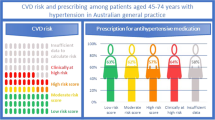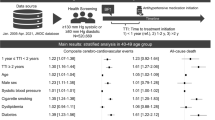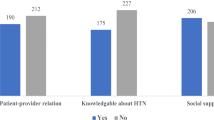Abstract
This study examined trends in the proportion of adults with self-reported hypertension and in antihypertensive medication use among community-dwelling Australian adults. We analysed data from a longitudinal panel study, covering four waves: 2009 (n = 8023), 2013 (n = 11,475), 2017 (n = 12,843), and 2021 (n = 14,571) for adults aged 18–74 years. Hypertension and antihypertensive medication use were self-reported. Healthcare subsidy was defined as the possession of a low-income healthcare card, a Pensioner Concession Card, or a Commonwealth Seniors Health Card. Prevalence estimates were age-standardised to the 2016 Australian Census population. The age-standardised prevalence of hypertension remained stable from 2009 to 2021, i.e., 15.7% (95% confidence interval [CI]: 15.1–16.4) in 2009 versus 15.2% (95% CI: 14.6–15.7) in 2021. Antihypertensive medication use increased from 39.4% (95% CI: 37.0–41.7) in 2009 to 46.7% (95% CI: 44.0–49.3) in 2021 (Pfor trend: 0.017). The adjusted prevalence ratios (PR) for hypertension were 1.17 (95% CI: 1.11–1.21) in the 1st (most disadvantaged) Socio-Economic Indexes for Areas (SEIFA) quintiles, compared with the 5th (most advantaged) quintile. The PR for antihypertensive medication use were 1.63 (95% CI: 1.11–1.47) in the 1st quintile compared with the 5th quintile. About 58% to 78% of the increased prevalence of hypertension and antihypertensive medication use related to socioeconomic disadvantage was mediated by healthcare subsidy. The prevalence of hypertension in Australia remained stable between 2009 and 2021. While hypertension drug treatment rates improved over the same period, it remains very low, with less than half of those who reported hypertension receiving antihypertensive medication. Healthcare subsidies improve hypertension detection and treatment, especially in socioeconomically disadvantaged groups.

This is a preview of subscription content, access via your institution
Access options
Subscribe to this journal
Receive 12 print issues and online access
$259.00 per year
only $21.58 per issue
Buy this article
- Purchase on SpringerLink
- Instant access to full article PDF
Prices may be subject to local taxes which are calculated during checkout




Similar content being viewed by others
References
Australian Institute of Health and Welfare. What do Australians die from? In: Life expectancy and deaths report July 2024. Archived: https://pp.aihw.gov.au/reports/life-expectancy-deaths/what-do-australians-die-from/contents/about (2025).
Xu X, Islam SMS, Schlaich M, Jennings G, Schutte AE. The contribution of raised blood pressure to all-cause and cardiovascular deaths and disability-adjusted life-years (DALYs) in Australia: Analysis of global burden of disease study from 1990 to 2019. PLoS ONE. 2024;19:e0297229.
Atkins ER, Nguyen LH, Chatterton ML, Schlaich M, Schutte AE, Rodgers A. The cost of treating hypertension in Australia, 2012–22: an economic analysis. Medical J Aust. 2024;221:612–6.
Australian Bureau of Statistics. National Health Survey: First Results, 2021–22. Released 6 December 2022. Archived: https://www.abs.gov.au/statistics/health/health-conditions-and-risks/national-health-survey/latest-release (2025).
Wang X, Shaw JE, Yu J, Jennings G, Stavreski B, Magliano D, et al. Prevalence, awareness, treatment, and control rates of hypertension in the general population of Australia: a systematic review and meta-analysis. J Hypertens. 2024;43:185–90.
Weintraub WS, Daniels SR, Burke LE, Franklin BA, Goff DC Jr, Hayman LL, et al. Value of primordial and primary prevention for cardiovascular disease. Circulation. 2011;124:967–90.
Schutte AE, Bennett B, Chow CK, Cloud GC, Doyle K, Girdis Z, et al. National Hypertension Taskforce of Australia: a roadmap to achieve 70% blood pressure control in Australia by 2030. Med J Aust. 2024;221:126–34.
Jeemon P, Séverin T, Amodeo C, Balabanova D, Campbell NRC, Gaita D, et al. World Heart Federation Roadmap for Hypertension - A 2021 Update. Glob Heart. 2021;16:63.
Park C, Wang G, Durthaler JM, Fang J. Cost-effectiveness analyses of antihypertensive medicines: a systematic review. Am J Prev Med. 2017;53:S131–42.
Pickersgill SJ, Msemburi WT, Cobb L, Ide N, Moran AE, Su Y, et al. Modeling global 80-80-80 blood pressure targets and cardiovascular outcomes. Nature Med. 2022;28:1693–9.
Zhou B, Danaei G, Stevens GA, Bixby H, Taddei C, Carrillo-Larco RM, et al. Long-term and recent trends in hypertension awareness, treatment, and control in 12 high-income countries: an analysis of 123 nationally representative surveys. Lancet. 2019;394:639–51.
Paige E, Banks E, Agostino J, et al. The relationship of socioeconomic factors to the use of preventative cardiovascular disease medications: a prospective Australian cohort study. Preventive Med. 2022;154:106884.
Australian Bureau of Statistics. National Health Survey: Information on health behaviours cp, and risk factors in Australia. Archived: https://www.abs.gov.au/statistics/health/health-conditions-and-risks/national-health-survey/2022#data-downloads (2025).
Musonge-Effoe JE, Alema-Mensah E, Effoe VS, Akinnawo F, Caplan L. The association between health care coverage and prevalence of cardiovascular diseases and diabetes over a 10-year period. Preventive Med. 2020;132:105983.
Wilkins RV-TE, Botha F. The Household, Income and Labour Dynamics in Australia Survey: Selected Findings from Waves 1 to 21. Melbourne Institute: Applied Economic & Social Research, University of Melbourne; 2024. Archived at: https://melbourneinstitute.unimelb.edu.au/__data/assets/pdf_file/0008/4841909/HILDA_Statistical_Report_2023.pdf (2025).
Summerfield, M, Garrard, B, Nesa, M, Kamath, R, Macalalad, N, Watson, N, et al. HILDA User Manual – Release 23. Melbourne Institute: Applied Economic and Social Research, University of Melbourne; 2024. Archived: https://melbourneinstitute.unimelb.edu.au/hilda/publications/hilda-statistical-reports (2024).
Australian Government Department of Health and Aged Care. PBS/RPBS Under Co-payment Prescriptions Data 2023-24. Archived: https://www.pbs.gov.au/info/statistics/under-co-payment/ucp-data-report#:~:text=From%201%20January%202024%20the,patients%20make%20toward%20their%20medicines (2025).
Watson N, Wooden MP. The HILDA survey: a case study in the design and development of a successful household panel survey. Longit Life Course Stud. 2012;3:369–81.
Baron RM, Kenny DA. The moderator-mediator variable distinction in social psychological research: conceptual, strategic, and statistical considerations. J Pers Soc Psychol. 1986;51:1173–82.
Rijnhart JJM, Twisk JWR, Chinapaw MJM, de Boer MR, Heymans MW. Comparison of methods for the analysis of relatively simple mediation models. Contemporary Clin Trials Commun. 2017;7:130–5.
Nolde JM, Streets F, Meyer D, Chen WS, Wei J, Wickramasinghe N, et al. Trends in blood pressure changes and hypertension prevalence in Australian adults before and during the COVID-19 pandemic. J Clin Hypertens. 2024;26:145–54.
Carnagarin R, Nolde JM, Yang J, Marques FZ, Picone DS, Lambert GW, et al. Stagnating rates of blood pressure control in Australia: insights from opportunistic screening of 10 046 participants of the May Measurement Month campaigns. J Hypertens. 2023;41:632–7.
Australian Institute of Health and Welfare. Heart, stroke and vascular disease: Australian facts, 2024. Archived: https://www.aihw.gov.au/reports/heart-stroke-vascular-diseases/hsvd-facts/contents/risk-factors/high-blood-pressure (2025).
Adams A, Kluender R, Mahoney N, Wang J, Wong F, Yin W. The Impact of Financial Assistance Programs on Health Care Utilization: Evidence from Kaiser Permanente. Am Econ Rev Insights. 2022;4:389–407.
Saxby K, Zhang Y. Bulk-billing rates and out-of-pocket costs for general practitioner services in Australia, 2022, by SA3 region: analysis of Medicare claims data. Med J Aust. 2024;222:144–8.
Khatib R, Schwalm JD, Yusuf S, Haynes RB, McKee M, Khan M, et al. Patient and Healthcare Provider Barriers to Hypertension Awareness, Treatment and Follow Up: A Systematic Review and Meta-Analysis of Qualitative and Quantitative Studies. PLOS ONE. 2014;9:e84238.
Acknowledgements
This paper uses unit record data from the Household, Income and Labour Dynamics in Australia (HILDA) Survey. The HILDA Project was initiated and is funded by the Australian Government Department of Social Services (DSS) and is managed by the Melbourne Institute of Applied Economic and Social Research (Melbourne Institute). The findings and views reported in this paper, however, are those of the author and should not be attributed to either DSS or the Melbourne Institute.
Author information
Authors and Affiliations
Corresponding author
Ethics declarations
Conflict of interest
RO is an employee of Astrazeneca Plc. The views expressed in this article are his own and do not represent that of his employers. All other authors declare no financial or non-financial competing interests.
Ethics approval
The HILDA Survey was approved by the Faculty of Business and Economics Human Research Ethics Committee at the University of Melbourne (Melbourne, Australia).
Additional information
Publisher’s note Springer Nature remains neutral with regard to jurisdictional claims in published maps and institutional affiliations.
Supplementary information
Rights and permissions
Springer Nature or its licensor (e.g. a society or other partner) holds exclusive rights to this article under a publishing agreement with the author(s) or other rightsholder(s); author self-archiving of the accepted manuscript version of this article is solely governed by the terms of such publishing agreement and applicable law.
About this article
Cite this article
Sahle, B.W., Magliano, D.J., Renzaho, A.M.N. et al. Socioeconomic inequalities and trends in self-reported hypertension and antihypertensive medication use in Australia between 2009 and 2021: a nationwide population-based cohort study. Hypertens Res (2025). https://doi.org/10.1038/s41440-025-02362-1
Received:
Revised:
Accepted:
Published:
DOI: https://doi.org/10.1038/s41440-025-02362-1



